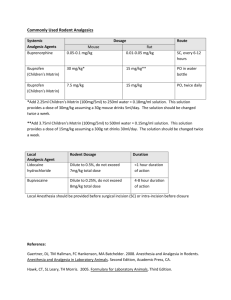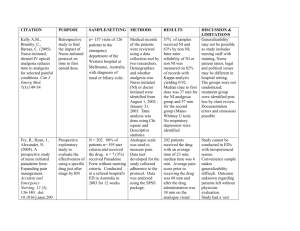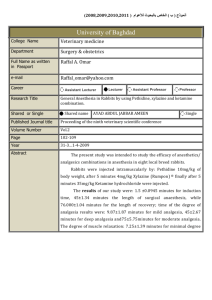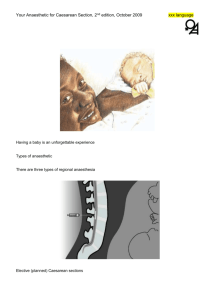M R
advertisement
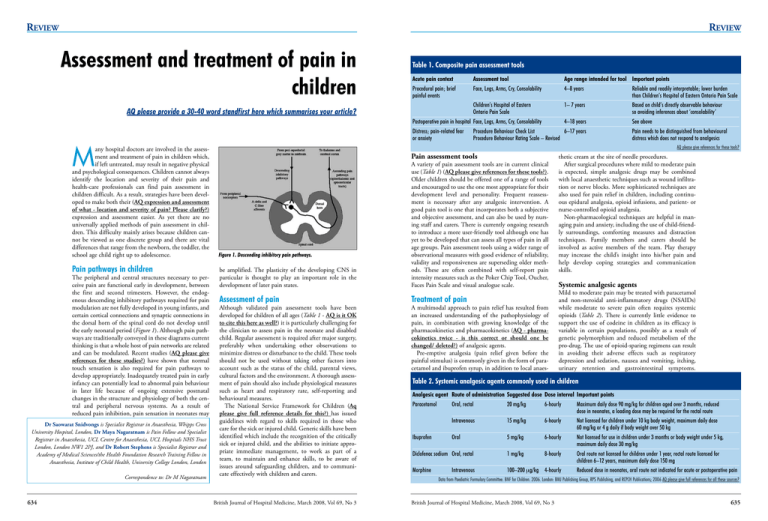
Review Review Assessment and treatment of pain in children AQ please provide a 30-40 word standfirst here which summarises your article? Table 1. Composite pain assessment tools Acute pain context Assessment tool Age range intended for tool Important points Procedural pain; brief painful events Face, Legs, Arms, Cry, Consolability 4–8 years Reliable and readily interpretable; lower burden than Children’s Hospital of Eastern Ontario Pain Scale Children’s Hospital of Eastern Ontario Pain Scale 1– 7 years Based on child’s directly observable behaviour so avoiding inferences about ‘consolability’ Postoperative pain in hospital Face, Legs, Arms, Cry, Consolability Distress; pain-related fear or anxiety M any hospital doctors are involved in the assessment and treatment of pain in children which, if left untreated, may result in negative physical and psychological consequences. Children cannot always identify the location and severity of their pain and health-care professionals can find pain assessment in children difficult. As a result, strategies have been developed to make both their (AQ expression and assessment of what - location and severity of pain? Please clarify?) expression and assessment easier. As yet there are no universally applied methods of pain assessment in children. This difficulty mainly arises because children cannot be viewed as one discrete group and there are vital differences that range from the newborn, the toddler, the school age child right up to adolescence. Pain pathways in children The peripheral and central structures necessary to perceive pain are functional early in development, between the first and second trimesters. However, the endogenous descending inhibitory pathways required for pain modulation are not fully developed in young infants, and certain cortical connections and synaptic connections in the dorsal horn of the spinal cord do not develop until the early neonatal period (Figure 1). Although pain pathways are traditionally conveyed in these diagrams current thinking is that a whole host of pain networks are related and can be modulated. Recent studies (AQ please give references for these studies?) have shown that normal touch sensation is also required for pain pathways to develop appropriately. Inadequately treated pain in early infancy can potentially lead to abnormal pain behaviour in later life because of ongoing extensive postnatal changes in the structure and physiology of both the central and peripheral nervous systems. As a result of reduced pain inhibition, pain sensation in neonates may Dr Saowarat Snidvongs is Specialist Registrar in Anaesthesia, Whipps Cross University Hospital, London, Dr Maya Nagaratnam is Pain Fellow and Specialist Registrar in Anaesthesia, UCL Centre for Anaesthesia, UCL Hospitals NHS Trust London, London NW1 2PJ, and Dr Robert Stephens is Specialist Registrar and Academy of Medical Sciences/the Health Foundation Research Training Fellow in Anaesthesia, Institute of Child Health, University College London, London Correspondence to: Dr M Nagaratnam 634 4–18 years Procedure Behaviour Check List 6–17 years Procedure Behaviour Rating Scale – Revised See above Pain needs to be distinguished from behavioural distress which does not respond to analgesics AQ please give references for these tools? Pain assessment tools be amplified. The plasticity of the developing CNS in particular is thought to play an important role in the development of later pain states. A variety of pain assessment tools are in current clinical use (Table 1) (AQ please give references for these tools?). Older children should be offered one of a range of tools and encouraged to use the one most appropriate for their development level and personality. Frequent reassessment is necessary after any analgesic intervention. A good pain tool is one that incorporates both a subjective and objective assessment, and can also be used by nursing staff and carers. There is currently ongoing research to introduce a more user-friendly tool although one has yet to be developed that can assess all types of pain in all age groups. Pain assessment tools using a wider range of observational measures with good evidence of reliability, validity and responsiveness are superseding older methods. These are often combined with self-report pain intensity measures such as the Poker Chip Tool, Oucher, Faces Pain Scale and visual analogue scale. Assessment of pain Treatment of pain Figure 1. Descending inhibitory pain pathways. Although validated pain assessment tools have been developed for children of all ages (Table 1 - AQ is it OK to cite this here as well?) it is particularly challenging for the clinician to assess pain in the neonate and disabled child. Regular assessment is required after major surgery, preferably when undertaking other observations to minimize distress or disturbance to the child. These tools should not be used without taking other factors into account such as the status of the child, parental views, cultural factors and the environment. A thorough assessment of pain should also include physiological measures such as heart and respiratory rate, self-reporting and behavioural measures. The National Service Framework for Children (Aq please give full reference details for this?) has issued guidelines with regard to skills required in those who care for the sick or injured child. Generic skills have been identified which include the recognition of the critically sick or injured child, and the abilities to initiate appropriate immediate management, to work as part of a team, to maintain and enhance skills, to be aware of issues around safeguarding children, and to communicate effectively with children and carers. British Journal of Hospital Medicine, March 2008, Vol 69, No 3 A multimodal approach to pain relief has resulted from an increased understanding of the pathophysiology of pain, in combination with growing knowledge of the pharmacokinetics and pharmacokinetics (AQ - pharmacokinetics twice - is this correct or should one be changed/ deleted?) of analgesic agents. Pre-emptive analgesia (pain relief given before the painful stimulus) is commonly given in the form of paracetamol and ibuprofen syrup, in addition to local anaes- thetic cream at the site of needle procedures. After surgical procedures where mild to moderate pain is expected, simple analgesic drugs may be combined with local anaesthetic techniques such as wound infiltration or nerve blocks. More sophisticated techniques are also used for pain relief in children, including continuous epidural analgesia, opioid infusions, and patient- or nurse-controlled opioid analgesia. Non-pharmacological techniques are helpful in managing pain and anxiety, including the use of child-friendly surroundings, comforting measures and distraction techniques. Family members and carers should be involved as active members of the team. Play therapy may increase the child’s insight into his/her pain and help develop coping strategies and communication skills. Systemic analgesic agents Mild to moderate pain may be treated with paracetamol and non-steroidal anti-inflammatory drugs (NSAIDs) while moderate to severe pain often requires systemic opioids (Table 2). There is currently little evidence to support the use of codeine in children as its efficacy is variable in certain populations, possibly as a result of genetic polymorphism and reduced metabolism of the pro-drug. The use of opioid-sparing regimens can result in avoiding their adverse effects such as respiratory depression and sedation, nausea and vomiting, itching, urinary retention and gastrointestinal symptoms. Table 2. Systemic analgesic agents commonly used in children Analgesic agent Route of administration Suggested dose Dose interval Important points Paracetamol Oral, rectal 20 mg/kg 6-hourly Maximum daily dose 90 mg/kg for children aged over 3 months, reduced dose in neonates, a loading dose may be required for the rectal route Intravenous 15 mg/kg 6-hourly Not licensed for children under 10 kg body weight, maximum daily dose 60 mg/kg or 4 g daily if body weight over 50 kg Ibuprofen Oral 5 mg/kg 6-hourly Not licensed for use in children under 3 months or body weight under 5 kg, maximum daily dose 30 mg/kg Diclofenac sodium Oral, rectal 1 mg/kg 8-hourly Oral route not licensed for children under 1 year, rectal route licensed for children 6–12 years, maximum daily dose 150 mg Morphine 100–200 mg/kg 4-hourly Intravenous Reduced dose in neonates, oral route not indicated for acute or postoperative pain Data from Paediatric Formulary Committee. BNF for Children. 2006. London: BMJ Publishing Group, RPS Publishing, and RCPCH Publications; 2006 AQ please give full references for all these sources? British Journal of Hospital Medicine, March 2008, Vol 69, No 3 635 Review However, NSAIDs should be used with caution in children with asthma or those at risk of renal injury. Local and regional anaesthesia The topical use of local anaesthetic in the form of EMLA cream (eutectic mixture of local anaesthetic: prilocaine and lidocaine) or amethocaine gel provides safe yet effective analgesia for all needle procedures (Table 3). Instillation or infiltration of local anaesthetic is useful for surface wounds. Regional anaesthesia involves the injection of local anaesthetic peripherally to block a nerve or nerve plexus, or centrally around the spinal cord or spinal nerve roots. Amide local anaesthetic agents are com- Table 3. Recommended maximum doses of EMLA in children Age Maximum Maximum skin dose (g) area (cm2) Important points 0–2 months 1 100 3–11 months 2 20 1–5 years 10 100 5–11 years 20 200 Do not exceed application time of 1 hour Data from manufacturer’s guidelines Table 4. Recommended maximum doses of amide local anaesthetics Amide local anaesthetic Maximum With adrenaline dose (mg/kg) (mg/kg) Important points Lidocaine 3 6 Bupivacaine 2 2 Levobupivacaine 2 Less cardiotoxic than bupivacaine Ropivacaine Less motor block than bupivacaine 3 Data from manufacturers’ guidelines. The maximum dose should serve only as a guide as there is often insufficient information, especially in paediatric use. Expert advice should always be sought because of the variability in absorption depending on such factors as the site of infiltration and the child’s metabolic status Abbreviations: mg=milligrammes; mcg=microgrammes (AQ no units here are mcg - is this correct?) KEY POINTS nUntreated pain in children is inhumane and can result in adverse physical and psychological consequences. nPain pathways continue to develop until early infancy and can be modulated. nA variety of pain assessment tools are available for children incorporating both subjective and objective measures. nA multimodal approach to pain relief involves pharmacological and nonpharmacological techniques. nPharmacological techniques include the use of systemic analgesic agents (nonsteroidal anti-inflammatory drugs and opioids). nLocal and regional techniques provide good analgesia for a wide range of indications. nNon-pharmacological techniques use child-friendly surroundings, comforting measures and distraction techniques. 636 monly used for this (Table 4). Peripheral nerve blocks (inguinal nerve blocks for hernia repair, penile blocks for circumcision) are used for long-lasting analgesia following surgery in conjunction with a general anaesthetic. Central neuraxial blocks (epidural and intrathecal analgesia) are also used successfully in children to provide pain relief. Epidural analgesia via the caudal approach remains a popular choice in paediatric anaesthetic practice, with a wide range of indications including circumcision and orchidopexy. Other measures Oral sucrose solution (‘sucrose analgesia’) or breastfeeding may minimize pain in neonates before minor invasive procedures. Nitrous oxide, as a 50:50 mixture with oxygen as Entonox, provides rapid analgesia for short painful procedures such as suturing and dressing changes. Conclusions Successful pain management in children involves the recognition and assessment of pain followed by safe and appropriate treatment. Infants and children of all ages perceive pain and have a right to adequate pain relief whether they can express their pain or not. A multimodal approach to pain relief should be adopted, incorporating both pharmacological and non-pharmacological approaches to effective pain relief. The authors would like to thank Dr Richard Howard, Consultant in Paediatric Anaesthesia and Pain Management, University College London Children Nationwide Pain Research Centre, Great Ormond Street Hospital for Children NHS Trust for his comments. Conflict of interest: ??? AQ please give a statement to run here -see covering letter? AQ please indicate where all references should be cited in the text? Howard RF (2003) Current status in pain management in children. JAMA 290(18): 2464–9 Lonnqvist PA, Morton NS (2005) Postoperative analgesia in infants and children. Br J Anaesth 95(1): 59–68 von Baeyer CL, Spagrud LJ (2007) Systematic review of observational (behavioural) measure of pain for children and adolescents aged 3 to 18. Pain 127(1-2): 140–50 British Journal of Hospital Medicine, March 2008, Vol 69, No 3
